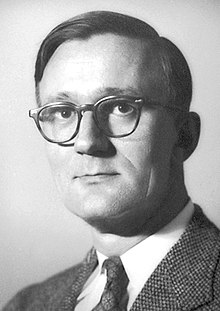| Polykarp Kusch | |
|---|---|
 Kusch in 1955 Kusch in 1955 | |
| Born | (1911-01-26)January 26, 1911 Blankenburg, Duchy of Brunswick, German Empire |
| Died | March 20, 1993(1993-03-20) (aged 82) Dallas, Texas, U.S. |
| Alma mater | University of Illinois Case Western Reserve University |
| Known for | Measuring the magnetic moment of the electron |
| Awards | Nobel Prize in Physics (1955) |
| Scientific career | |
| Fields | Physics |
| Institutions | University of Texas at Dallas Columbia University |
| Thesis | The molecular spectra of caesium and rubidium (1936) |
| Doctoral advisor | Francis Wheeler Loomis |
| Doctoral students | Eugene D. Commins Gordon Gould Sheldon Schultz [de] |
Polykarp Kusch (German: [ˈpoːliˌkaʁp ˈkuʃ]; January 26, 1911 – March 20, 1993) was a German-American physicist who shared the 1955 Nobel Prize in Physics with Willis Eugene Lamb for his accurate determination that the electron magnetic moment was greater than its theoretical value, thus leading to reconsideration of and innovations in quantum electrodynamics.
Early life and education
Kusch was born in Blankenburg, Germany to John Mathias Kusch, a Lutheran missionary, and his wife, Henrietta van der Haas. In 1912, Kusch and his family had emigrated to the United States, where by 1922 he became a naturalized citizen. After graduating from grade school in the Midwest, Kusch attended Case Institute of Technology in Cleveland, Ohio (now known as Case Western Reserve University), where he majored in physics. After graduating from the Case Western Reserve University with bachelor of science degree in 1931, Kusch joined University of Illinois at Urbana–Champaign, from where he received his master's degree in 1933. He continued his education at the same alma mater, studying for his Ph.D. under mentorship from F. Wheeler Loomis and after defending his thesis titled "The Molecular Spectrum of Caesium and Rubidium", graduated from it in 1936. In 1935, prior to moving to the University of Minnesota, Kusch married his girlfriend, Edith Starr Roberts. Together, they had three daughters.
Career
Kusch then moved to New York City, where from 1937 and until his departure for the newly founded University of Texas at Dallas, he spent much of his career as a professor at Columbia University, and served as the university's provost for several years. He worked on molecular beam resonance studies under I. I. Rabi, then discovered the electron anomalous magnetic moment. Many measurements of magnetic moments and hyperfine structure followed. He expanded into chemical physics and continued to publish research on molecular beams. During his tenure at Columbia, he was the doctoral supervisor for Gordon Gould, the inventor of the laser.
Kusch was a fellow of the American Physical Society since 1940 and of the American Academy of Arts and Sciences since 1959. He was elected a member of the National Academy of Sciences in 1956. In 1967, he was elected to the American Philosophical Society.
Kusch's wife Edith died in 1959, and in the following year he married Betty Pezzoni. They had two daughters. Kusch House, a residential dormitory for undergraduate students at Case Western Reserve University in Cleveland, Ohio on the South Campus, is named after Kusch. It is located on Carlton Road in Cleveland Heights. The University of Texas at Dallas has a Polykarp Kusch Auditorium with a plaque.
Kusch died on March 20, 1993, aged 82. His widow Betty died in 2003, aged 77.
Publications
- Rabi, I. I.; Zacharias, J. R.; Millman, S.; Kusch, P. (1938). "A New Method of Measuring Nuclear Magnetic Moment". Physical Review. 53 (4): 318. Bibcode:1938PhRv...53..318R. doi:10.1103/PhysRev.53.318.
- Rabi, I. I.; Millman, S.; Kusch, P.; Zacharias, J. R. (1939). "The Molecular Beam Resonance Method for Measuring Nuclear Magnetic Moments. The Magnetic Moments of 3Li6, 3Li7 and 9F19". Physical Review. 55 (6): 526–535. Bibcode:1939PhRv...55..526R. doi:10.1103/PhysRev.55.526.
- Rabi, I. I.; Zacharias, J. R.; Millman, S.; Kusch, P. (1992). "Milestones in Magnetic Resonance: 'A new method of measuring nuclear magnetic moment'. 1938". Journal of Magnetic Resonance Imaging. 2 (2): 131–133. doi:10.1002/jmri.1880020203. PMID 1562763. S2CID 73238886.
- Kusch, P.; Foley, H. M. (1948). "The Magnetic Moment of the Electron". Physical Review. 74 (3): 250–263. Bibcode:1948PhRv...74..250R. doi:10.1103/PhysRev.74.250. PMID 17820251.
See also
References
- ^ Norman F. Ramsey. "Polykarp Kusch" (PDF). National Academy of Sciences. pp. 3–4.
- "APS Fellow Archive".
- "Fellows of the American Academy of Arts and Sciences" (PDF). American Academy of Arts and Sciences. Retrieved December 27, 2019.
- "APS Member History". search.amphilsoc.org. Retrieved 2022-09-22.
External links
 Media related to Polykarp Kusch at Wikimedia Commons
Media related to Polykarp Kusch at Wikimedia Commons- Polykarp Kusch on Nobelprize.org
 including his Nobel Lecture, December 12, 1955 The Magnetic Moment of the Electron
including his Nobel Lecture, December 12, 1955 The Magnetic Moment of the Electron - Browne, Malcolm W. (March 23, 1993). "Polykarp Kusch, Nobel Laureate In Physics in 1955, Is Dead at 82". The New York Times.
Related archival collections
- Haskell A. Reich collection of student notes, circa 1945-1954, Niels Bohr Library & Archives (includes lecture notes from Polykarp Kusch's courses at Columbia University)
| 1955 Nobel Prize laureates | |
|---|---|
| Chemistry |
|
| Literature (1955) |
|
| Peace |
|
| Physics |
|
| Physiology or Medicine |
|
- 1911 births
- 1993 deaths
- People from Blankenburg (Harz)
- Scientists from the Duchy of Brunswick
- Emigrants from the German Empire to the United States
- 20th-century American physicists
- 20th-century German physicists
- University of Illinois Urbana-Champaign alumni
- Case Western Reserve University alumni
- Columbia University faculty
- University of Texas at Dallas faculty
- Nobel laureates in Physics
- American Nobel laureates
- Fellows of the American Academy of Arts and Sciences
- Fellows of the American Physical Society
- Members of the United States National Academy of Sciences
- Members of the American Philosophical Society
